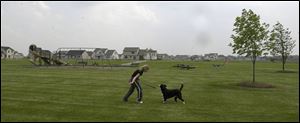
Zoning rules require space
5/16/2004
A sweeping swath of open green is incorporated into the recently built Saddlebrook subdivision in Wood County's Middleton Township.
AS THE grandfather of 10, Jim Bostdorff admitted he is very interested in making sure children have large open spaces where they can play baseball and other sports.
As a trustee in fast-growing Middleton Township in Wood County, Mr. Botsdorff thinks he has a way to ensure it: redo zoning rules for proposed subdivisions to require large enough green space to throw a ball.
"If you're going to put 100 houses here, back to back, I think you need some planned space and not use it all up," said Mr. Bostdorff, a farmer.
Most local townships and cities, as well as county plan commissions, have provisions that require developments to have green space.
But the latest twist is how to define it and how much to require. Government officials and developers are not always in agreement, for example, on whether to count water features and walking trails as green space or on whether small, scattered plots of green space are acceptable or whether a larger open area is better.
"Many of the designs fulfill the requirements, but whether it is a philosophical match is what we're looking for," said Dave Steiner, director of the Wood County Planning Commission.
Commission members will be asked soon if they want to be on a committee to address Mr. Bostdorff's concerns.
Wood County requires that 5 percent of a subdivision be open space, and water features generally are not counted. If a developer does not want that kind of green space, he or she can opt to pay 5 percent of what was spent on land to the local park district.
Each township and community in the county may have its own requirements too.
In Perrysburg Township, the county's required 5 percent is the rule for regular subdivisions, but 20 percent of green space is required for a planned unit development, such as a condo project, and 30 to 50 percent is needed in "a cluster subdivision," which has houses on small lots and closer together, said Grant Garn, zoning inspector.
The township initially spelled out green space provisions when a developer came to the trustees with an elaborate plan for ponds, streams, and walking trails and it didn't meet the criteria at the time, Mr. Garn said.
In Lucas County, regulations adopted last year say that 3 percent of the land included in a new subdivision should be green space or the developer has to pay 3 percent of the value of the entire acreage into a park fund, said John Nagy, principal planner for the Toledo-Lucas County Plan Commission.
"Green space takes away the feeling of being crowded in your subdivision, it allows for storm-water absorption whether through the ground or into a pond, and it allows you to preserve natural habitats for wildlife," said Mr. Nagy.
Monroe County has no county-wide provisions on green space.
However, Bedford Township requires developments of condominiums or zero-lot-line villas to have 30 percent dedicated to open space, but imposes no such requirements on regular subdivisions.
Dennis Jenkins, township planning and zoning coordinator, said no one has applied for a permit under a state-mandated ordinance that allows homes to be closely clustered on half the plot if the remaining land is dedicated to open
space.
The green-space issue is a concern for area developers, who say they want to balance the desires of township and county officials, home buyers, and the practical realities of a project, said Craig Harris, president of the Home Builders Association of Greater Toledo Inc.
"You're damned if you do and damned if you don't, because a park or a walking trail is a feature that attracts buyers, but it's not an amenity that people like once they're in," he said.
Doug Wamsher, of MillStream Development in Sylvania Township, said developers generally want green space, but how it is required can be a problem.
Although residents like the idea of having a walking path outside their door, they might not like their dog barking at each passing dog, which may or may not be picked up after by its owner.
Plus, any common space needs to be maintained, which means a homeowners association with dues is needed, and those costs climb with a larger open space area, Mr. Wamsher said. Water features cost even more to maintain, said the developer of Twelve Lakes subdivision in Sylvania Township.
Green space upkeep could cost a homeowner from $5 to more than $1,000 a year, he estimated.
Mr. Harris, president of WestValley Development in Toledo, said RiverBend, his planned subdivision in Middleton Township, has more than 5 percent of its land devoted to green space, but most of that is in the form of lakes, which township trustees have indicated they might not consider green space.
"A developer makes no money on green space and it could become a substantial cost if there's a loss of lot revenue," Mr. Harris said. "We've got to balance what we think [the market] will want and where it's bloated."
Contact Mary-Beth McLaughlin at
mmclaughlin@theblade.com
or 419-724-6199.